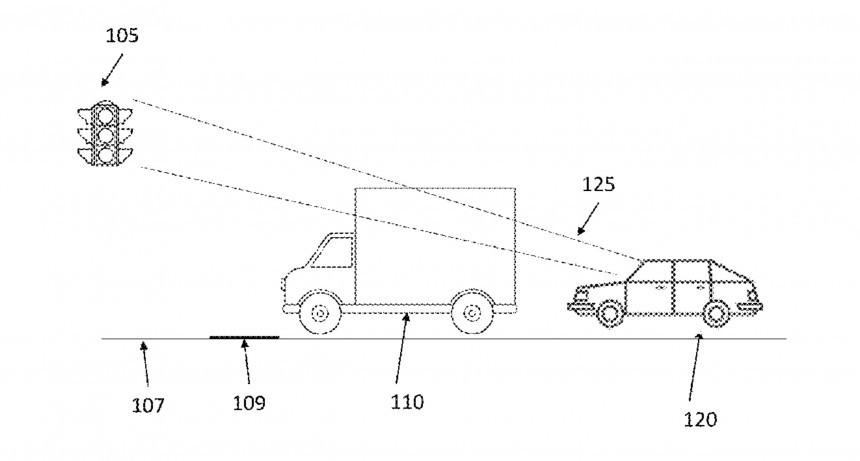We've all been there. Large vehicles, be they lorries or buses, traveling in front of us and obstructing our field of view, sometimes making it impossible to see the color of the upcoming traffic light.
The example scenario might not sound like a big deal if you keep a reasonable distance from the vehicle in front, but even so, anticipating what happens on the road is extremely important from a safety perspective.
Even so, making the road more predictable has become an essential part of traffic safety, and autonomous vehicles are living proof of why having all data available all the time is critical. A self-driving car must read road signs and traffic lights at any moment.
General Motors has recently patented new technology that could address this significant annoyance, allowing drivers to see through the other vehicles on the road. Literally, that is, as the American carmaker wants to use hardware available on new-generation cars, as well as advanced software processing, to project what happens in front of the vehicle traveling ahead of you on an augmented reality screen in the car.
In plain English, GM believes your car could create a virtual view of a traffic light, show it on an onboard screen, and let you see it easily to slow down in advance if required.
The carmaker acknowledges that large vehicles, including lorries, make it hard for drivers of passenger cars or even SUVs to see a traffic light. In some cases, this leads to the driver engaging the brakes at the last minute, eventually increasing the risk of accidents for the vehicles traveling in the same lane.
General Motors believes its "traffic light visibility detection and augmented display" patent could address this shortcoming.
First, the company explains that the vehicle must become aware of the location of every traffic light on the road. While this goal sounds impossible to achieve, the carmaker believes navigation software, up-to-date maps, smart infrastructure, and even onboard cameras scanning the road ahead can provide valuable data in this regard. GM's technology brings all the information from these sources under the same roof, eventually allowing the vehicle to know precisely where a traffic light is located.
Based on this data, the vehicle is already prepared to read the traffic light when you approach an intersection. The onboard cameras, including a LiDAR system, can scan the car traveling in front of you. The purpose is to determine its dimensions and calculate whether it can obstruct your field of view. If the system determines that you may not be able to see the traffic light, the new technology comes into play.
The next step in GM's new-generation concept is to receive traffic light information. In other words, the digital version you'll see on your screen, be it the instrument cluster, a head-up display, or an AR screen integrated into the windshield, must correctly indicate the traffic color light. If the light turns red, you should see this in your car. If it's green, you can continue your journey.
General Motors says the concept involves receiving permanent traffic light information. Once again, the carmaker explains it can use multiple sources, including smart traffic infrastructure that can communicate directly with the vehicles on the road and the other vehicles themselves. The vehicle-to-vehicle concept could power two-way communications, allowing cars to exchange data to power this system. Even if a lorry or a bus blocks your field of view, other vehicles still have a clear view of the traffic light. They can monitor the traffic light and feed live information to your onboard system.
Eventually, GM's technology puts together all this data, including a digital scan of the road, the location of the traffic light, the dimensions of the vehicle in front, and the traffic light status data, into a system that creates the augmented reality view in front of your eyes. The driver can eventually see through the vehicle in front and know in advance if they must slow down or maintain the speed without risking running a red light.
GM's technology wouldn’t work without two-way communication between vehicles and other cars on the road or the traffic infrastructure. This clearly indicates that bringing it to mass production today is nearly impossible, as the company doesn’t have the necessary hardware (not necessarily for its cars but to feed data into the system) to power the AR system.
However, I'm sure General Motors is planning in advance and believes there'll be a time when seeing through the large vehicle in front would make perfect sense for a driver. Still, the technology is now in the patent stage. While carmakers typically fill these applications "just in case," the American carmaker might be aiming for the sky if the automotive world eventually creates always-connected traffic to let vehicles communicate efficiently.
Even so, making the road more predictable has become an essential part of traffic safety, and autonomous vehicles are living proof of why having all data available all the time is critical. A self-driving car must read road signs and traffic lights at any moment.
General Motors has recently patented new technology that could address this significant annoyance, allowing drivers to see through the other vehicles on the road. Literally, that is, as the American carmaker wants to use hardware available on new-generation cars, as well as advanced software processing, to project what happens in front of the vehicle traveling ahead of you on an augmented reality screen in the car.
In plain English, GM believes your car could create a virtual view of a traffic light, show it on an onboard screen, and let you see it easily to slow down in advance if required.
General Motors believes its "traffic light visibility detection and augmented display" patent could address this shortcoming.
First, the company explains that the vehicle must become aware of the location of every traffic light on the road. While this goal sounds impossible to achieve, the carmaker believes navigation software, up-to-date maps, smart infrastructure, and even onboard cameras scanning the road ahead can provide valuable data in this regard. GM's technology brings all the information from these sources under the same roof, eventually allowing the vehicle to know precisely where a traffic light is located.
Based on this data, the vehicle is already prepared to read the traffic light when you approach an intersection. The onboard cameras, including a LiDAR system, can scan the car traveling in front of you. The purpose is to determine its dimensions and calculate whether it can obstruct your field of view. If the system determines that you may not be able to see the traffic light, the new technology comes into play.
The next step in GM's new-generation concept is to receive traffic light information. In other words, the digital version you'll see on your screen, be it the instrument cluster, a head-up display, or an AR screen integrated into the windshield, must correctly indicate the traffic color light. If the light turns red, you should see this in your car. If it's green, you can continue your journey.
General Motors says the concept involves receiving permanent traffic light information. Once again, the carmaker explains it can use multiple sources, including smart traffic infrastructure that can communicate directly with the vehicles on the road and the other vehicles themselves. The vehicle-to-vehicle concept could power two-way communications, allowing cars to exchange data to power this system. Even if a lorry or a bus blocks your field of view, other vehicles still have a clear view of the traffic light. They can monitor the traffic light and feed live information to your onboard system.
GM's technology wouldn’t work without two-way communication between vehicles and other cars on the road or the traffic infrastructure. This clearly indicates that bringing it to mass production today is nearly impossible, as the company doesn’t have the necessary hardware (not necessarily for its cars but to feed data into the system) to power the AR system.
However, I'm sure General Motors is planning in advance and believes there'll be a time when seeing through the large vehicle in front would make perfect sense for a driver. Still, the technology is now in the patent stage. While carmakers typically fill these applications "just in case," the American carmaker might be aiming for the sky if the automotive world eventually creates always-connected traffic to let vehicles communicate efficiently.










